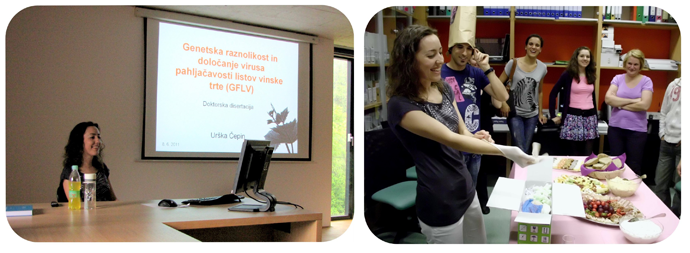21
Sep
Urška Čepin
On Wednesday, 6th June 2011, on Biotechnical Faculty, University of Ljubljana, Urška Čepin defended her doctoral thesis entitled »Genetic variability and detection of Grapevine Fanleaf Virus« in the field of biotechnology. Her supervisor was prof. dr. Maja Ravnikar and her co-supervisor doc. dr. Maruša Pompe Novak.
On Wednesday, 6th June 2011, on Biotechnical Faculty, University of Ljubljana, Urška Čepin defended her doctoral thesis entitled »Genetic variability and detection of Grapevine Fanleaf Virus« in the field of biotechnology. Her supervisor was prof. dr. Maja Ravnikar and her co-supervisor doc. dr. Maruša Pompe Novak.Dr. Urška Čepin started with her experimental work in 2006 as a young researcher at the Department of biotechnology and systems biology.
During her PhD she studied virus GFLV (Grapevine Fanleaf Virus), which is economically most important virus in grapevine industry, because it is the causal agent of the most severe viral disease on grapevines: grapevine degeneration disease. The aim of her doctoral thesis was to determine the distribution and presence of GFLV in different parts of different grapevine cultivars during the season in order to find appropriate material for the most reliable GFLV detection. In frame of this study she also developed and validated new real-time PCR method for general detection and quantification of GFLV, which is 1000-fold more sensitive than conventional ELISA test. This enables more reliable detection of GFLV infection during the clonal selection and better interpretation and elimination of the disease from the vineyards.
The second aim of the doctoral thesis was to get better insight into the genetic variability of a satellite RNA (satRNA), which is molecule uncapable of replication and transmission in absence of its helper virus, in this case GFLV. Only one available sequence of satRNA of GFLV means this has been the least extesively investigated molecule of GFLV. More than 130 new sequences revealed that satRNA has similar characteristics as genomic RNA molecules of its helper virus, which means it is extremely variable and what is even more interesting it seems it can change and quickly adapt to a new helper viruses, in our case on ArMV (Arabis Mosaic Virus), the closest relative of GFLV virus. This knowledge helps to better understand and predict how quickly viral genome of GFLV can change and adapt to new conditions.






